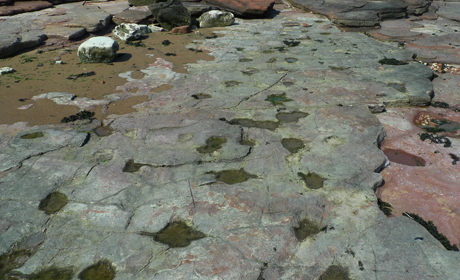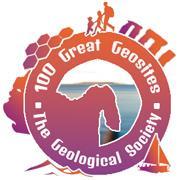Dinosaur Footprints, Bendrick Rock
Vale of Glamorgan, Wales

Bendrick Rock in Barry, South Glamorgan is one of the UK's most important coastal geological localities and is listed as both a Site of Special Scientific Interest (SSSI) and a Geological Conservation Review Site (GCR). The GCR lists the locality twice, for its stratigraphy and for its exceptional fossil reptile tracks.
 This foreshore site is famous for its 220 million year old, Triassic Red Bed deposits which show remarkable dinosaur footprints and trackways. The footprints occur over wide areas and many individual trackways can be identified on single bedding plains. The dinosaurs that made these prints were relatively primitive, having not long evolved from crocodile-like ancestors.
This foreshore site is famous for its 220 million year old, Triassic Red Bed deposits which show remarkable dinosaur footprints and trackways. The footprints occur over wide areas and many individual trackways can be identified on single bedding plains. The dinosaurs that made these prints were relatively primitive, having not long evolved from crocodile-like ancestors.
The exposure itself provides extensive outcrop of the Upper Triassic, Mercia Mudstone Series where the stratigraphy is dominated by fine red mudstones, marls, ripple bedded sandstones and occasional conglomerates. The sediments here are recognised as important palaeoenvironmental indicators, recording a time when climate in this area was predominantly arid and terrestrial but with occasional periods of heavy rainfall. The sediments and climatic conditions that existed in the Triassic Period are similar to those found in a modern sabkha or playa basins like those found in North Africa around Abu Dhabi.
Bendrick Rock 220 Million Years Ago
 During the Late Triassic it is probable that the Bendrick Rock area was a low lying marginal environment, where large ephemeral fluvial (river and stream) systems sporadically filled a larger, heavily evaporated, hypersaline lake.
During the Late Triassic it is probable that the Bendrick Rock area was a low lying marginal environment, where large ephemeral fluvial (river and stream) systems sporadically filled a larger, heavily evaporated, hypersaline lake.
The fluvial deposits are interpreted as the result of periodic flash flood events and show a range of sediments and depositional structures. The rivers that existed in this area would have periodically filled the lakes and during times of heavy rainfall burst their banks creating extensive shallow floodplains. These flood events would have deposited fine muds over a wide area and left many shallow pools of rapidly evaporating water.
About the Dinosaurs
 The footprints found here were made by several different dinosaurs, the smaller footprints and tracks are assigned to the ichnogenus Grallator and were probably made by a small, 1m tall, theropod dinosaur such as Coelophysis. Coelophysis would have been a small predatory dinosaur that may have hunted in packs. The larger 3 toed theropod footprints are rarer and are attributed to the ichnogenus Anchisauripus.
The footprints found here were made by several different dinosaurs, the smaller footprints and tracks are assigned to the ichnogenus Grallator and were probably made by a small, 1m tall, theropod dinosaur such as Coelophysis. Coelophysis would have been a small predatory dinosaur that may have hunted in packs. The larger 3 toed theropod footprints are rarer and are attributed to the ichnogenus Anchisauripus.
Prints left by large four toed dinosaurs are also found, these probably belong to the ichnogenus Tetrasauripus and were made by a fairly large, 7-8m long, plant eating dinosaur something like Plateosaurus. These dinosaurs were protosauropods, four legged dinosaurs which were capable of walking on its hind legs despite having fairly sturdy front legs too.
Illegal Fossil Collecting

In 2005 slabs of rock containing footprints were illegally collected from beach at Bendrick Rock Site of Special Scientific Interest. These footprints appeared for sale on the internet and in fossil shops in both the UK and USA.
Countryside Council for Wales worked with the police to track down the fossil collector and recover the stolen fossils. The collector was prosecuted and the fossil footprints have been returned to Amgueddfa Cymru - National Museum of Wales.
Please do not collect or damage fossil material at this site, Bendrick Rock is of international importance and a wonderful part of Wales’ geological heritage. Help us look after the footprints by reporting any damage or collecting. Contact us bigcprojectmanager@gmail.com or Natural Resources Wales to report any illegal fossil collecting or vandalism.
Text: Ben Evans
Related Links
- Download the South Wales Geological Association's guide to the footprints
- Amgueddfa Cymru - National Museum Wales
- The Geological Conservation Review
Grid Reference
- ST 144 677
Images (top to bottom):
- Dinosaur Footprints © Ben Evans, National Museum Wales
- Dinosaur footprints on the foreshore © MarnixR (Source Wikimedia Commons) Creative Commons Attribution-Share Alike 3.0 Unported
- Ripple bedded sandstones © Ben Evans, National Museum Wales
- Footprints on rippled bed © Ben Evans, National Museum Wales
- Rockpool in footprint © Ben Evans, National Museum Wales

October 13 - 21
Theme: 'Earth Science in our lives'
